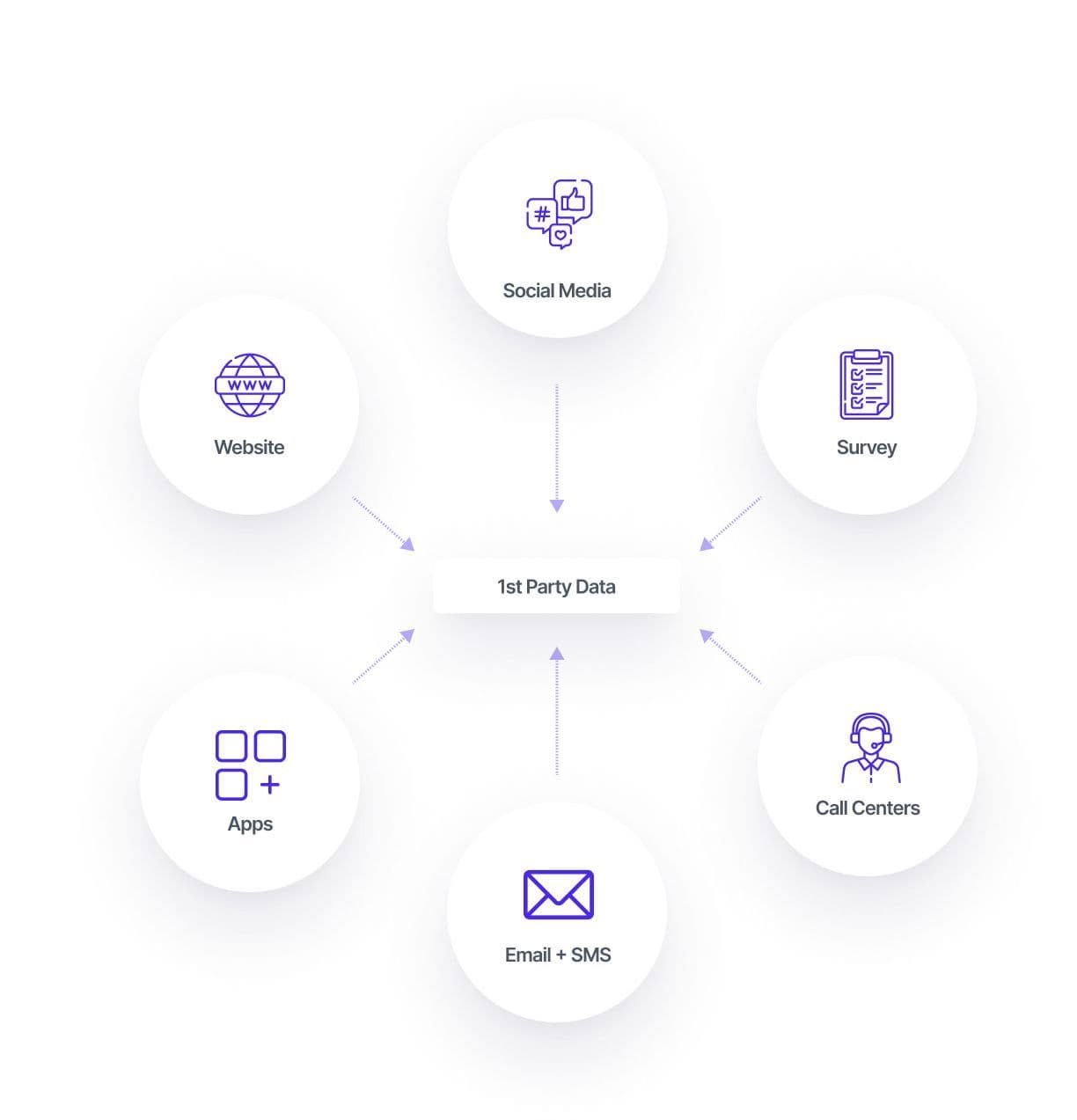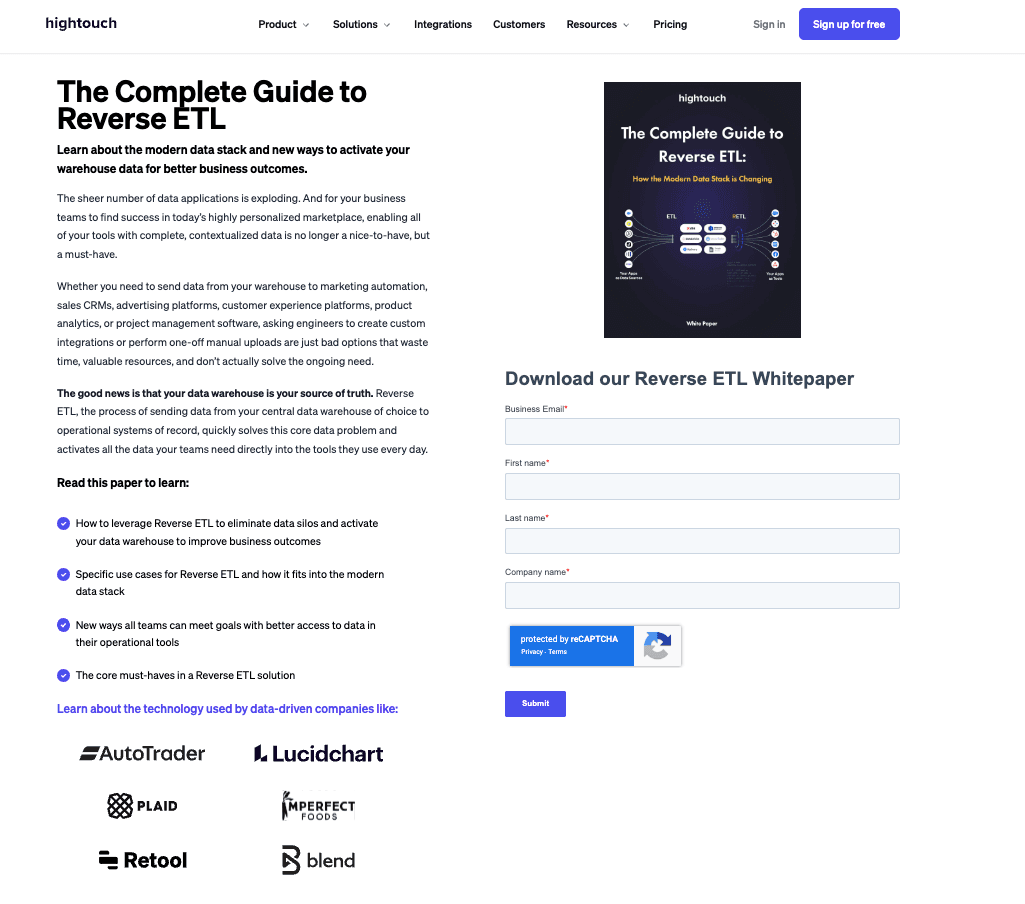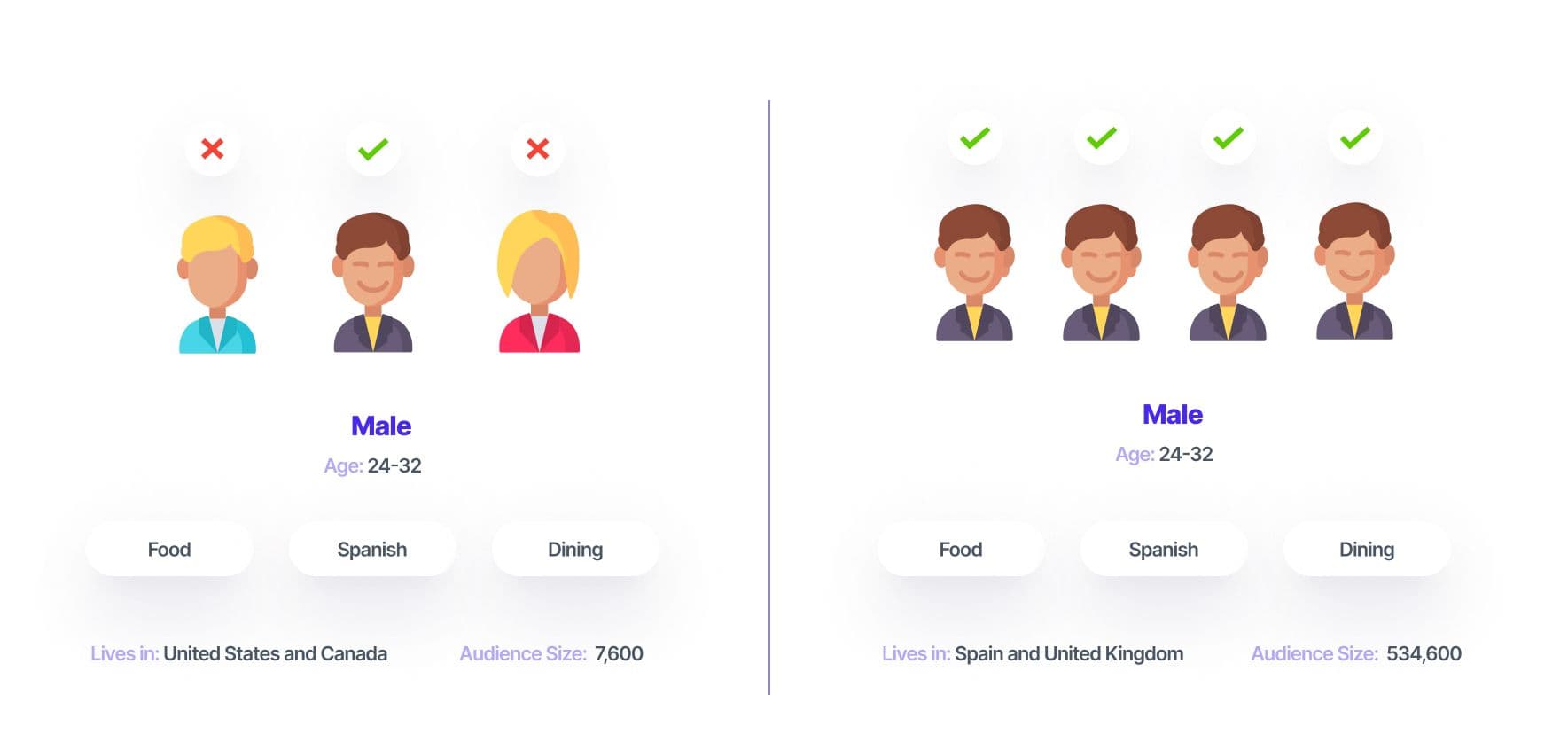In modern marketing, customer personalization is key, but in order to build the personalized experiences customers now expect, it helps to have a good understanding of your customers. One of the best ways to do this is by gathering data. There are different types of customer data that can benefit your data-driven marketing.
Two major types of data are 1st party and 3rd party data. In this article, we will look at each one, how you can use them, how you collect them, and their differences.
What Is 1st Party Data?
1st party data is collected directly from your customers. It can be gathered from:
- Your website/app
- Your social media pages
- Customer surveys
- SaaS
- Internal databases

Different types of 1st party data
It’s one of the most cost-effective data types because you collect it yourself. It’s more reliable because it’s data you own and know exactly where it came from. You also have fewer privacy concerns as you’ve had consent to collect it.
1st party data helps you to learn from past customers, deepen your customer relationships, and increase the ROI of your digital marketing campaigns.
How Do You Collect 1st Party Data?
You can collect 1st party data from a range of different places. Some of these methods require customers to enter their information, while others collect it from user behaviors and interactions.
Create 360° User Profiles in your Warehouse
Learn how to stitch your existing customer data into rich, actionable profiles directly in your data warehouse without writing a line of code.
Download this document to learn more about Hightouch's Adaptive Identity Resolution and how warehouse-native identity and entity resolution empowers companies with the best-possible uses for their data.


Product Usage Data
You can collect 1st party data directly from your product, and it’s one of the richest forms of data you can collect. The way online users interact with your product can help you learn what’s working and what’s not so you can improve.
If we take Spotify as an example, some of the data that you can collect directly through the app are:
- Last login date
- Number of playlists
- Top played song
- Top genres
- Time spent in the app
Spotify can then take that information and send emails if the last login date is greater than 30 days to try and get them back on the app or send notifications of new music from the artists in the top playlist.
Event Data
Events include the key behavioral data and actions that customers are taking on your website or app (e.g. item added to cart, pages viewed, workspace created, signup, abandoned cart). In the past, to even capture this data you needed to take advantage of web pixels and third-party cookies.
However, with all of the major internet browsers changing their stance on consumer privacy and the rapid adoption of ad blockers, this is no longer feasible. These days, you’ll probably want to leverage an event collection platform like Snowplow so you can own your event collection in-house rather than using a third-party provider.
If you want to deepen your understanding of this topic, you can read our definitive guide to conversion APIs & web pixels.
SaaS Applications
The internal SaaS applications used by your various business teams are probably the number one source for 1st party data. For most companies, this includes things like
- Sales data (first meeting, demo date, job title, industry)
- Finance data (lifetime value, average order value, annual recurring revenue)
- Customer support data (total tickets, number of phone calls, customer emails)
Most of the time, this type of data is collected automatically or inputted manually in tools like Hubspot, Salesforce, Netsuite, or Zendesk.
Quizzes
Quizzes make collecting 1st party data fun for the customers because you reward them for their actions. And to them, it doesn’t really feel like giving away their data. Clicking on options rather than typing in your personal information disguises the fact their data is being gathered.
An example could be a quiz on your product so you can see how well they know certain features. If you noticed that a customer scored low on a particular feature, you could put them into an email nurture campaign to teach it to them.
Or the “What type of XX” are you?” You see the viral effort of these quizzes on social media, with people posting their results for others to see, enticing others to try them. These quizzes tend to ask more personal questions to give you your results.
Forms
Just like paying taxes, filling in a lead generation form is something everyone has done. If you haven’t filled in a form, you probably haven’t been on the Internet before.

Example of a form
A lead gen form should be a method of trading value between the customer and the company (we say should because sometimes companies fail to offer ANY value). The company should offer something of value, such as an ebook, a whitepaper, or the promise of a weekly newsletter with valuable information. And the customer receives the high-value item by giving their name, email address, or other types of information.
The main focus here is making sure you can persuade the customer to provide you with their 1st party data by offering an attractive “enticement.”
How Do You Store 1st Party Data?
Typically, you store 1st party data in the tool that gathers it. So you could have some 1st party data in your production database that runs your app or in a lifecycle marketing platform like Braze or Iterable. You can also store your data in a customer data platform (CDP).
Thanks to the modern data stack more companies are benefiting from a data warehouse. Data warehouses give you the ability to consolidate all of your data across all of your many different data sources into a single, centralized location so your data engineering team can transform and model it in a way that makes sense to your business.
Until data warehouses came along it was really hard to answer analytics-related questions like
- Who’s the most active user in an account?
- When did customer X last login to the app?
- What’s the average order value of our customers in X location?
- What’s the relation between support tickets and customer churn?
- What’s the average session length of customers who order in the past 30 days?
There are several benefits to having a data warehouse including
- Data consolidation: a data warehouse gives you a single source of truth.
- Data consistency: a data warehouse enables you to transform and model your data for your business.
- Data activation: taking your business data and easily syncing it to downstream tools.
- Business Intelligence: You don’t need to go to your other systems to find the data you need.
Having a data warehouse means you’re in a great place to take advantage of Data Activation. Having all your company data in one place means you can take the created models and benefit from them in your downstream business tools by using Hightouch.
How Can You Use 1st Party Data?
1st party data is accurate and relevant because it comes directly from your very own customers and users. There are many benefits to 1st party data, and you can use it in many different ways. All of these methods are a key part of a marketing strategy.
Retargeting
A quick Google search will show the crazy returns that retargeting can do for your business. Who wouldn't want a 10x the clickthrough rate on display ads or to achieve a 70% conversion rate for revisits to your website?
These figures wouldn’t be possible without retargeting. Retargeting is a method of bringing awareness back to your brand after a customer has interacted with your company.
Some of the most common examples would be showing ads to customers who had visited your website but didn’t convert or showing an ad for an item a customer put in their cart but didn’t buy.
Lookalike Audiences
Are you looking to start running ads to draw in new leads but not sure where to find them? Using lookalike audiences will help you. Lookalike audiences try to find people similar to your existing audience, helping to increase the chances of customers responding to your ads.

Lookalike audience example
Most advertising platforms will support lookalike audiences. All you need is a list of your existing customers. The advertising platform will then look at the demographics, behaviors, and interests of the audience that you supplied to identify similar people and create an entirely new audience of potential customers.
Depending on how experimental you are, you can alter the percentage of how closely you want your current audience to match the new audience.
Personalization
You open up your emails first thing Monday morning and see this email.
“Going, going, nearly gone!
We saw you checking out the super chill water bottle and wanted to let you know we only have ten left!
Our next batch of water bottles won’t be available for another three months, so grab yours before we’re sold out.”
The above email is a perfect example of personalization. From your 1st party data, you know that this customer was looking at a specific bottle, and you know the stock levels of the item—you can put all of this information into a custom email and send it to your customer.
You can enhance your email with your customer’s data, which helps to build personalized experiences and increase the chance of a conversion.
Lifecycle Marketing
The chance of someone seeing your brand for the first time and pulling out their credit card is low. Of course, it can happen, but usually, you have a period where your customer needs to get to know you and build a direct relationship based on trust.
And how can a company help nurture that relationship? They can use lifecycle marketing. People describe lifecycle marketing as “always on” marketing, which you achieve through marketing automation and various platforms.
You can help build trust and recognition with your customer through
- Offers, and win-back emails
- Ad retargeting
- Website personalizations
- Or direct mail and phone contact
Sharing that information with all of your systems makes 1st party data important for lifecycle marketing. Some companies find this challenging, but with Data Activation you can empower all of your systems with the same data.
What Is 3rd Party Data?
3rd party data is data that you buy from an external source. These outside sources aggregate data from many different places and buy 1st party data from other companies. They then combine it all and sell it as 3rd party data.
Some data aggregators organize it by industry, demographic characteristics such as age or gender, and audience behavior. With the data having audience segments you can purchase data specifically for your needs.
How Can You Use 3rd Party Data?
One of the key benefits of 3rd party data is that you can get volume. And the volume of data can help you in a few different ways.
Customized Experience
All the demographic, behavioral, and industry data you can get from 3rd party data can help you customize the customer user experience to a more favorable one.
Let’s say that you sell sunglasses online, and your target audience is teenagers aged 18-24. With the help of 3rd party data, you might find that males between 18-20 are more likely to buy if shown a discount. So for that sub-group, you can place a popup giving them a 10% discount on your website.
Broaden Your Audience
There’s only so much information you can gather for your 1st party data, short of asking customers everything about their lives. But that’s the great thing about 3rd party data. You can get access to a lot more data points which can help broaden your audience.
Say, for example, you’re a house moving company. The primary ways you get customers are people who come directly to you or via your social media ads spray and pray technique.
If you could get a 3rd party data set that showed you people who have bought a house or are looking for homes on the market, you know these are a much better audience to target your ads with.
Uncover New Audiences
Generally, 1st party data tends to be more precise and relevant, but 3rd party data can help increase the amount of data you have access to and help you discover new audiences you weren’t aware of.
Analyzing your 1st party and 3rd party data might result in you finding an intersection between the interests of two different demographics, which you wouldn’t link together, unlocking new audience insights.
How Do You Get 3rd Party Data?
You often get 3rd party data from a demand side platform (DSP), a data management platform (DMP), or data exchanges.
Some of the most popular data exchanges are:
Some of the examples of 3rd party data you can get are:
- Viewership behavior
- Socioeconomic data
- Weather data
- Health data
- Demographic data
- Geographic data
- Point of sale data
What Is the Difference Between 1st and 3rd Party Data?
The main difference between 1st and 3rd party data is that 1st party data is something that you collect yourself from event collectors such as Google Analytics, lead gen forms, or your internal applications used in your different company departments such as Hubspot, Salesforce, Braze, and LaunchDarkly.
3rd party data is other companies 1st party data that has been collected, compiled, and made available to buy. You can buy as little or as much as you want or data specific to your needs.
Which Is Better, 1st or 3rd Party Data?
Now you are familiar with both 1st and 3rd party data, which is better?
The great thing about 3rd party data is that you can get it in bulk. Sometimes you don’t have the time or the resources to gather buckets full of data, so you need a shortcut. The problem is that 3rd party data comes at a cost, and you also don’t know where it’s been collected and how accurate it is.
1st party data can be slow to gather as you have to rely on your audience to physically enter their information or interact with your website or product. The benefit is that you know exactly where it came from, and you can be pretty confident that the data is correct.
In a world where customers are more aware of their data and privacy concerns, 3rd party data may be harder to get hold of, and you’ll have to rely on gathering data for yourself, so starting collecting 1st party data would be a wise choice.
What’s Next: Data Activation
Phew!
Hopefully, you now understand the differences between 1st party data and 3rd party data. Understanding your data is only one side of the story, Data Activation is the next act of the story.
There’s no point in putting all that effort into gathering all of that 1st and 3rd party data together in your warehouse only to have it sit and rot in a dashboard. This is where Hightouch can help. As a Data Activation platform powered by Reverse ETL, Hightouch takes the data stored in your warehouse and syncs it directly to 100+ different destinations.
- Want to send an audience to Google Ads for retargeting?
- Want to sync product usage data to your customer relationship management (CRM)?
- Want to segment an audience and sync it to your marketing tool?
All of this can be done simply with Hightouch. Learn more about Data Activation or create a Hightouch account for free!
Create 360° User Profiles in your Warehouse
Learn how to stitch your existing customer data into rich, actionable profiles directly in your data warehouse without writing a line of code.
Download this document to learn more about Hightouch's Adaptive Identity Resolution and how warehouse-native identity and entity resolution empowers companies with the best-possible uses for their data.

















